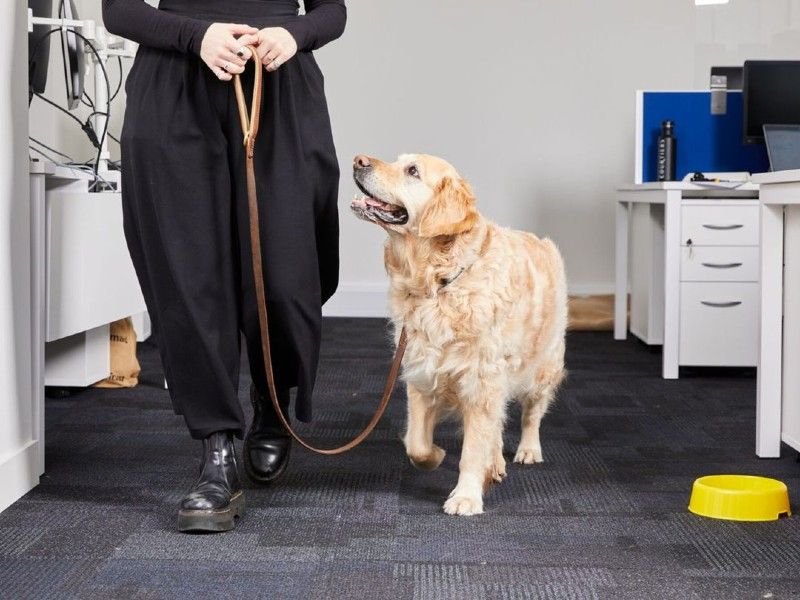Bringing your dog to work: top tips and advice
Are you considering taking your dog into the office with you? Find out how to prepare them for a day at work.

Taking your dog to work with you is incredibly exciting – for you and your four-legged friend.
There’s a new environment, new smells and lots of new friends to be made. Introduce your workplace to your dog in a positive way, and watch your dog become employee of the month in no time.
Start at home
All great office dogs start their training at home. Teaching your dog basic skills, as well as getting them used to sitting or lying quietly while you work, can be practiced at home. Some useful skills for your dog to know before entering the workplace include sitting or lying down when asked, learning to settle when you can’t give them attention, learning to stay and of course, knowing what it means to leave it.
Make sure your dog is up to date on all their vaccinations, deworming, de-flea and tick treatments too. If you’re not sure, contact your vet.
Introductions to strangers
If your dog gets over-excited when greeting people, they will benefit from learning a calmer response so that they don’t overdo it in the workplace, and your colleagues and clients will benefit too! You can start training this either in your home or out and about on familiar walks.
Your dog will soon learn that calm greetings, free from jumping up or barking, are rewarded with attention, and it will become their go-to response when meeting new people.
Introduce the commute
Think about how you normally get to work. Do you walk, use your car, or take public transport? Is your dog familiar and comfortable with the method and length of journey?
It’s important that your dog is relaxed not only at your workplace, but during the commute too. If your dog is not already confident with the method of travel, as well as the time of travel (rush hour, anyone?) you may need to begin taking them out, little by little, to help them get comfortable with your route to work. Try short walks, car journeys or trips on public transport at the weekend when it’s less busy, and work up to longer and more busy journeys.
Prepare your workspace
The next step is to prepare your workspace for your dog’s arrival. Have a think about the layout of your working area.
Does your dog have somewhere to settle comfortably in a safe and quiet space? If your usual desk or workspace is close to a busy area with lots of footfall, can you move to a quieter area, like in a corner or close to a wall? Is the area hazard-free? Have you removed all wires and items that your dog might be tempted to chew on or get tangled up in? Is there appropriate (non-slip) flooring? If not, can you bring in a non-slip mat?
Do you have a safe place to put your dog’s enrichment, water, food where it won’t get in the way, or be too close to other dogs?
Prepare your colleagues
We all need to work in harmony. Make sure to have clear and open communication with your colleagues and agreements in advance of how you will all work together when your pup is present.
Some things to think about might be: Are your colleagues happy to have dogs at work? Does your dog need to avoid someone with an allergy? Does everyone understand your dog’s needs and boundaries? Will colleagues be tolerant of the occasional bark or a little mess? Accidents sometimes happen!
If your dog has any food allergies or intolerances, make sure your colleagues know about these, as well as what foods and substances are generally dangerous for dogs.
Prepare a puppy pack and back-up plan
Just like you pack your handbag, briefcase, or rucksack for work every day, your dog will need a pack with all the essential supplies to ensure they have a good day in the office.
Make sure you pack:
- uniform – their collar, tag, harness (if they wear one) and lead
- refreshments – food, water, bowls, treats and any medication they might need
- soft furnishings – a bed, blanket or mat for them to snooze on
- entertainment – toys, enrichment games, long-lasting chews
- cleaning – poo bags, a towel, dog friendly enzymatic cleaner for any accidents that might occur.
Make sure you have a back-up plan for if anything goes wrong! Can someone at work care for your dog if you need to step into an important meeting where they can’t join you? If your dog appears to be stressed or sick, can you leave work and take them home?
Gradual introductions to the workplace
Introducing your dog to your workplace is best done gradually, to avoid your dog becoming overwhelmed.
You could start by bringing them in for some half-days, if possible, before trying to bring them in one or two days spread throughout the week.
Gradually build up the number of days you bring them in during the week until they are fully familiar with your workplace and routine, and are showing signs that they are fully relaxed in their new space.
Try a full week
When your dog is not showing signs of anxiety or frustration on the days they’re in the workplace with you, you can try bringing them in every day for a week and see how they react.
Remember, your dog might cope very well on Monday and Tuesday, but by Wednesday might become fed up or a little overwhelmed, and this could mean that Thursday or Friday might be too much for them to cope with.
Knowing how to read your dog’s body language is an important skill. Find out how you can spot signs that your dog is stressed or is struggling to cope.
Enjoy your companionship
Once you have successfully completed all the steps and your dog is a happy, healthy hound in the workplace, you can enjoy their wonderful daily companionship, including the great excuse to pop outside for some fresh air for you and a bathroom break for your dog.
Establishing a routine for such breaks will help your dog stay settled and enjoy their time with you.
Related articles
.jpg)







